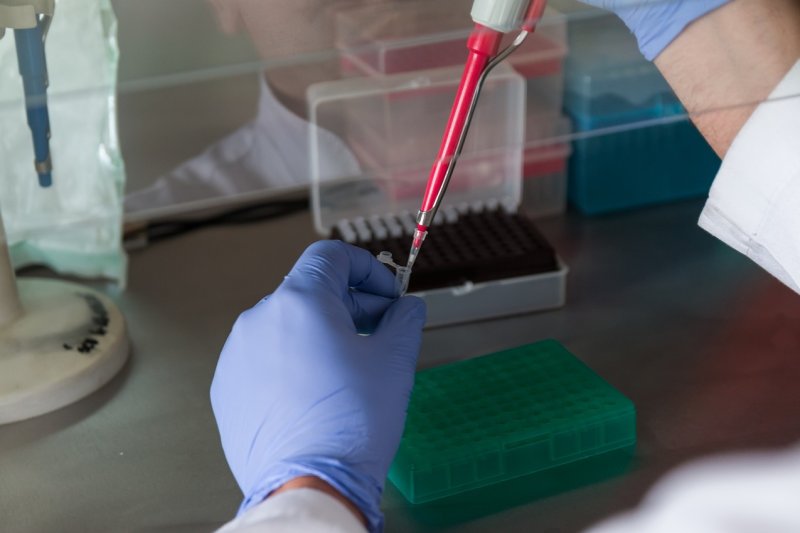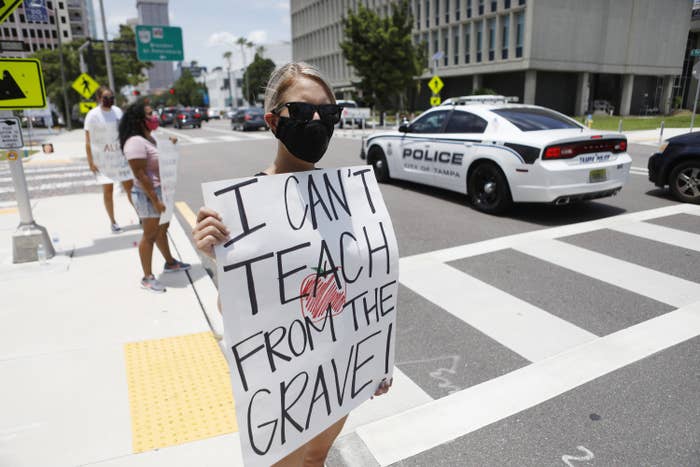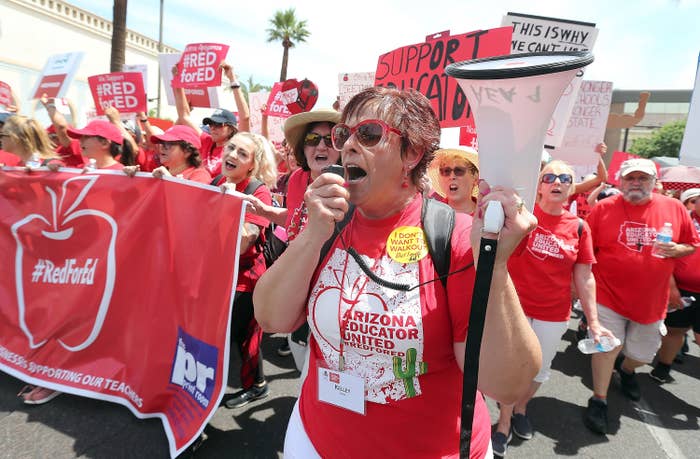Former Officials Say The Elite Border Patrol Unit Sent To Confront Portland Protesters Is Like A “Fish Out Of Water”
"This is political theater for an audience of one.”
Last updated on July 24, 2020

Caitlin Ochs / Reuters
Federal law enforcement officers, deployed under the Trump administration's new executive order to protect federal monuments and buildings, face off with protesters against racial inequality and police violence in Portland, Oregon, on July 21.
Before dawn on April 22, 2000, heavily armed federal agents smashed their way into a home in Miami’s Little Havana neighborhood, wrenching a 6-year-old Cuban boy named Elián González from his relatives.
The raid, captured in an unforgettable image of the terrified child coming face to face with a helmeted agent brandishing an assault rifle, marked the end of a very public custody battle between Cold War adversaries. For most Americans it also provided a first glimpse at the methods employed by the Border Patrol Tactical Unit, or BORTAC, which once again finds itself at the center of a national controversy after being deployed to the streets of Portland, Oregon, to confront protesters.
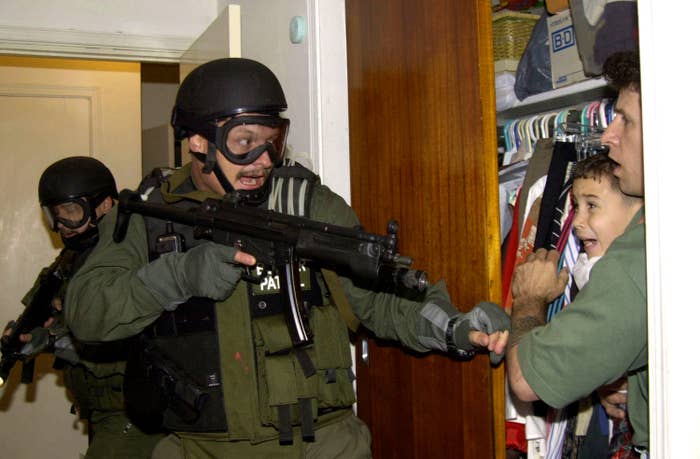
Alan Diaz / AP Images
Armed federal agents seizing Elián González early Saturday morning, April 22, 2000, in Miami.
Local officials and other critics say the tactical unit, which is trained for high-risk missions and usually conducts operations along the border targeting smugglers and criminal organizations, shouldn’t be responding to a matter of civil dissent in a major city far from any national border. Since arriving last week, BORTAC agents have reportedly been apprehending protesters and whisking them away in unmarked vans, sometimes without revealing who they are or providing any legal justification for the detentions. Oregon’s attorney general, in a lawsuit filed Friday against the Department of Homeland Security, identified two cases of alleged “snatch and grab” arrests they suspect were carried out by BORTAC agents.
“The fundamental disconnect here is that these forces are being used against American citizens,” said Doris Meissner, a former Clinton administration official who as head of the Immigration and Naturalization Service oversaw the González operation. “It’s a really serious misuse of federal law enforcement authorities as well as agencies whose missions are important but very different. It’s basically hijacking local law enforcement’s responsibilities and duties that they are equipped to carry out.”
Her criticism echoed the sentiments of other former and current federal officials who believe the tactical unit is being misused by the Trump administration as a reelection ploy. BORTAC is not trained for deescalation, but rather an overwhelming force most often meant to combat-hardened criminals and terrorists, Meissner said.
Footage of BORTAC agents detaining a protester on the streets of Portland and pulling them into an unmarked van earlier this month sparked widespread outrage. Some likened the camouflage agents to the gestapo or stormtroopers of Nazi Germany. The video, shared widely on Twitter, shows two BORTAC agents approaching a protester wearing all black. Off camera, a woman keeps asking the agents what they’re doing and who they are. The agents don't say a word; they walk their captive over to a waiting unmarked van and speed off.
The agents had the word “police” emblazoned on the front of their uniforms, but the other patches are difficult to see. Much of the criticism stems from reports of agents refusing to identify themselves and from the fact that they have been wearing militaristic camouflage uniforms in an urban environment.
Mark Pettibone, a Portland resident who was similarly taken away in an unmarked van, on Monday submitted an affidavit in Oregon’s lawsuit against DHS in which he said the two men in military fatigues approached him without identifying themselves.
"I was detained for up to two hours," Pettibone said in his statement. "No one informed me as to which agency had abducted, detained or questioned me. I am still unaware as to which agency or agencies were involved."
Another video posted to Twitter on Wednesday showed a group of baton-wielding BORTAC agents violently confronting a line of Portland's so-called Wall of Moms. Agents could also be seen throwing canisters emitting smoke at the protesters.
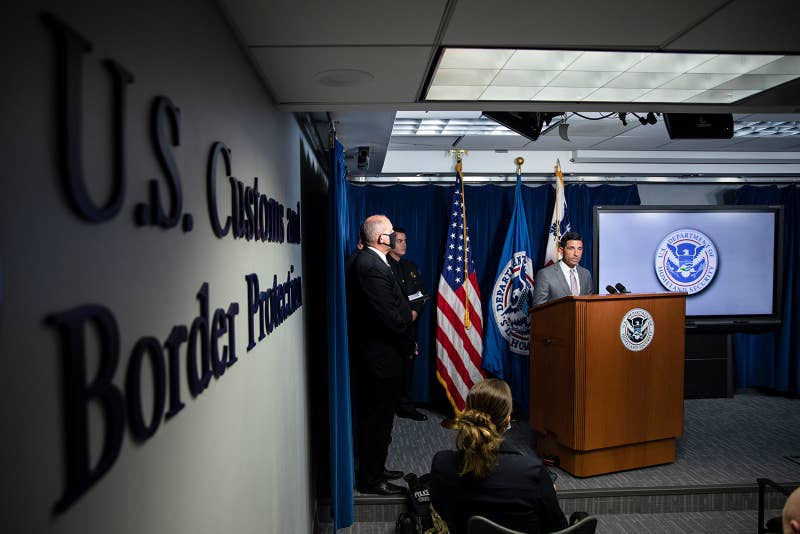
Samuel Corum / Getty Image
Acting Secretary of Homeland Security Chad Wolf speaks during a July 21 press conference on the actions taken by Customs and Border Protection and Homeland Security agents in Portland in Washington, DC.
Trump administration officials have defended the federal agents’ actions. Acting DHS Secretary Chad Wolf said during a press conference Tuesday it was not true that BORTAC agents wore no identification. In addition to patches that said “police” in yellow lettering, he said they also wore patches that mark them as being with Border Patrol and its parent agency, Customs and Border Protection, as well as a unique three-letter identifier. Unlike most local law enforcement, BORTAC agents do not have name tags, making individual officers difficult if not impossible to identify.
On Friday, a federal judge denied the Oregon attorney general’s request for an order requiring federal law enforcement officers in Portland to identify themselves when making arrests and place limits on the detention and arrests of protesters.
Trump administration officials have said they ordered the agents into Portland to protect federal buildings during weeks of demonstrations against anti-Black racism and police brutality, arguing local authorities aren’t doing enough.
“The smear attacks leveled against our officers is disgusting,” Wolf told reporters Tuesday.
Rep. Jim Clyburn and House Speaker Nancy Pelosi referred to federal agents as “gestapo” and “stormtroopers,” respectively, in discussing footage of officers taking protesters off the streets in unmarked vans. Oregon’s senior senator, Ron Wyden, on Wednesday tweeted at Trump: “get your jackbooted goons out of my city.”
On Thursday, the DHS’s Office of Inspector General informed lawmakers it had opened an investigation into allegations that agency personnel “improperly detained and transported” protesters in Portland. The office will also examine the deployment of DHS law enforcement personnel in the city. The investigation is coordinated with the Department of Justice, which launched its own inquiry on Thursday.
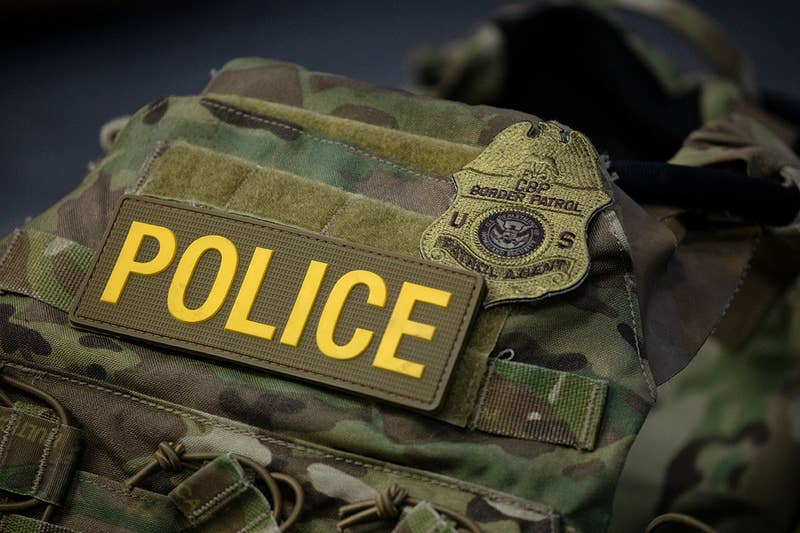
Samuel Corum / Getty Images
A protective vest with identifying markings worn by Border Patrol is seen during a press conference on July 21 in Washington, DC.
Created in 1984 to respond to riots inside immigration detention facilities, BORTAC was trained in a way that mirrors aspects of the US special operations forces’ selection courses, and it has been described by agents as mentally and physically grueling.
The special response team was also deployed to the streets of Los Angeles in 1992 in response to the riots. In 2002, the unit was sent to help secure the Salt Lake City Winter Olympics as the nation feared another terrorist attack less than a year after 9/11.
Wolf said the agents, whose camouflage uniforms he called “completely appropriate” given that they usually work near the US-Mexico border, would only leave Portland when the violence against federal buildings and officers stopped. He also called on local officials to step up and protect their community.
"We will not retreat. … We will continue to take the appropriate action to protect our facilities and our law enforcement officers," Wolf said.
Kris Cline, principal deputy director of the Federal Protective Service, said at the same Tuesday press conference that the man seen in a video being taken away by BORTAC agents in an unmarked van was questioned for less than 20 minutes before being released. The border agents wanted to ask him about protesters pointing lasers at the eyes of federal authorities and took him in the van because they wanted to question him away from the crowd, Cline added.
"Unfortunately, it got spun out of control with the rhetoric about what happened,” he said.
In a statement, CBP said the agents’ names were not displayed due to recent doxing incidents against law enforcement officials and described the crowd approaching them as a “large and violent mob.” But the widely shared video of the demonstrator being detained shows about five people, some questioning the agents and trying to get the protester’s name in order to help get them released. Oregon Attorney General Ellen Rosenblum also disputed CBP’s account.
“The video of that unknown person’s detention shows no evidence of a ‘mob’ at all, let alone the agents appearing to note or react to a ‘large and violent mob,’” Rosenblum said in a motion for a temporary restraining order against the federal agents being deployed in Portland.
Acting CBP Commissioner Mark Morgan also defended the use of BORTAC in Portland, saying the officers have been trained in riot control.
But Gil Kerlikowske, a former CBP commissioner who served in the Obama administration, said he questioned whether the agents had the appropriate training to handle the situation unfolding in Portland. Handling a demonstration inside an Immigration and Customs Enforcement facility or even at an official border crossing is not the same as going into an urban area where residents are engaged in civil disobedience, he said.
Kerlikowske, who has served as Seattle’s police chief, also said he believed deploying camouflage-clad agents who could not readily be identified by name sends the wrong message and fuels tensions.
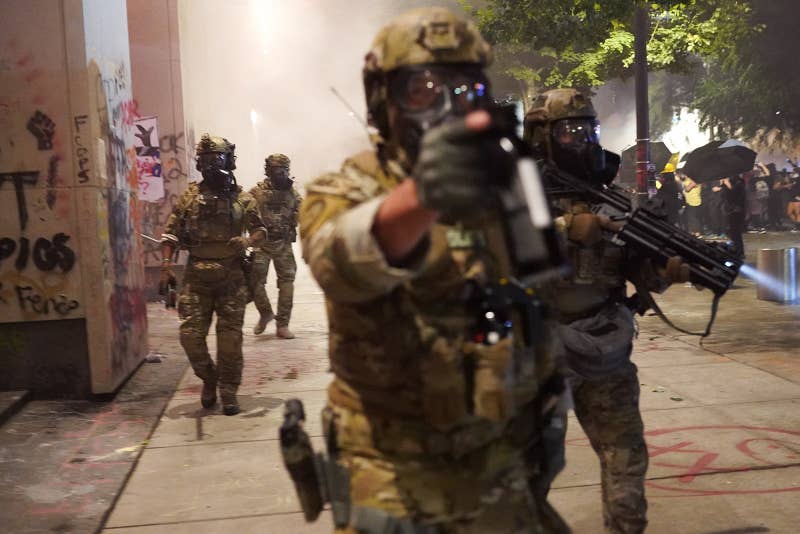
Nathan Howard / Getty Images
Federal police disperse a crowd of about 1,000 protesters at the Mark O. Hatfield US Courthouse on July 20 in Portland.
BORTAC is a tactical unit more akin to the Marine Forces Special Operations Command or the FBI's hostage rescue team that is used to working in remote, rugged areas along the border, so the team’s like "a fish out of water" when it comes to guarding federal buildings in an urban area and dealing with crowds of protesters, he added.
"This is political theater for an audience of one," Kerlikowske said, referring to Trump, who he said wants to demonstrate his facade of “toughness.” He also noted that the homeland security secretary, the CBP commissioner, and the ICE director were all appointed to their jobs in a temporary capacity, without confirmation by the Senate. “They're one tweet away from being fired, so who are they going to attempt to please?" he asked.
John Sandweg, a former lead DHS official in the Obama administration, noted that because border agents are used to operating near the border where the agency exercises authority to conduct stops, seizures, and detentions without a warrant, their deployment to a city with a population of nearly 700,000 was bound to lead to problems. That at-will power is one most Americans don’t know about and has long been decried by advocates who maintain the agency doesn’t legally have those additional powers.
“To put them in the middle of a city — they don’t receive training to operate in that environment,” Sandweg said. “This was a real mistake.”
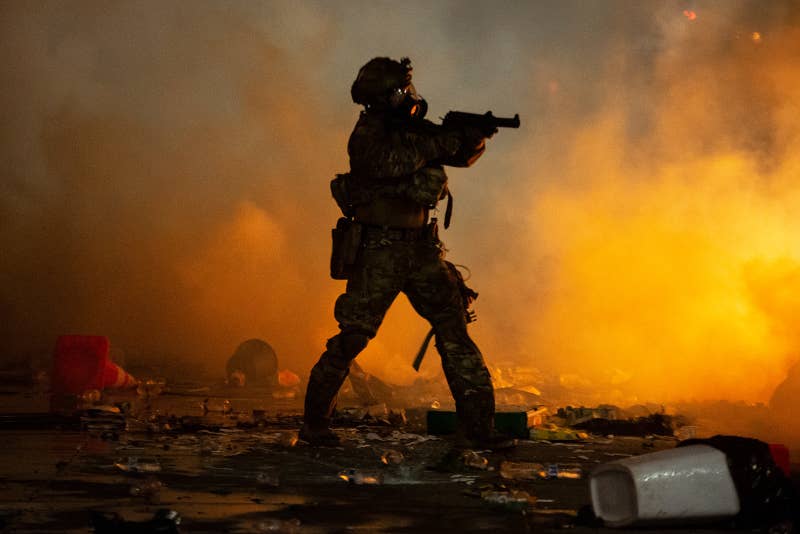
Nathan Howard / Getty Images
A federal officer points a "less-lethal" weapon toward a crowd of a few hundred protesters in front of the Mark O. Hatfield US Courthouse on July 23 in Portland.
Last week, the New York Times reported that an internal memo addressed to Wolf said federal agents deployed by DHS were not specifically trained in riot control or mass demonstrations. Wolf told reporters he never saw the memo.
Although CBP has provided very little information about what BORTAC agents have done in Portland, some information about their actions has come out in court documents filed as part of criminal charges against demonstrations.
In a complaint against Giovanni Bondurant, who was charged Wednesday with felony assault of a federal officer, a BORTAC agent, identified only as “agent victim 1,” said he confronted two protesters who were throwing rocks and bottles at law enforcement agents. The agent, assigned to the BORTAC delta squad, said he identified himself as a Border Patrol agent and ordered them to stop and drop their shields. When one of the protesters tried to run away, the BORTAC agent said, he grabbed the man’s arm and started to remove his shield. That’s when the agent said he was struck by another protester from behind.
“This rioter pulled me to the ground and began striking my chest and head,” the agent said in a written statement referenced in the complaint. “I gained control of the rioter’s hand and arm. I then restrained the rioter and applied flexible restraints to his hands.”
Vicki Gaubeca, director of the Southern Border Communities Coalition, which brings together 60 organizations across the southwest border, said that in light of the George Floyd protests, CBP should be reevaluating its tactics and focus on how to deescalate civil unrest “instead of doing the opposite.”
"These actions are setting a precedent that is going to be hard to roll back if we don't nip it in the bud," she said. ●
MORE ON THIS
A Judge Won’t Force Federal Officers In Portland To Identify Themselves When Making Arrests
Zoe Tillman · July 24, 2020
Zoe Tillman · July 24, 2020
Zoe Tillman · July 23, 2020

Hamed Aleaziz is a reporter for BuzzFeed News and is based in San Francisco.
Adolfo Flores is a reporter for BuzzFeed News and is based in McAllen, Texas..

Kendall Taggart is an investigative reporter for BuzzFeed News and is based in New York.
